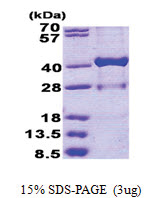17-beta-HSD1 / HSD17B1 (1-328, His-tag) Human Protein
CAT#: AR50925PU-N
17-beta-HSD1 / HSD17B1 (1-328, His-tag) human recombinant protein, 0.25 mg
Other products for "HSD17B1"
Specifications
| Product Data | |
| Species | Human |
| Expression Host | E. coli |
| Expression cDNA Clone or AA Sequence |
MGSSHHHHHH SSGLVPRGSH MGSHMARTVV LITGCSSGIG LHLAVRLASD PSQSFKVYAT LRDLKTQGRL WEAARALACP PGSLETLQLD VRDSKSVAAA RERVTEGRVD VLVCNAGLGL LGPLEALGED AVASVLDVNV VGTVRMLQAF LPDMKRRGSG RVLVTGSVGG LMGLPFNDVY CASKFALEGL CESLAVLLLP FGVHLSLIEC GPVHTAFMEK VLGSPEEVLD RTDIHTFHRF YQYLAHSKQV FREAAQNPEE VAEVFLTALR APKPTLRYFT TERFLPLLRM RLDDPSGSNY VTAMHREVFG DVPAKAEAGA EAGGGAGPGA EDEAGRGAVG DPELGDPPAA PQ
|
| Tag | His-tag |
| Predicted MW | 37.5 kDa |
| Concentration | lot specific |
| Purity | >90% by SDS - PAGE |
| Buffer | Presentation State: Purified State: Liquid purified protein Buffer System: 20 mM Tris-HCl buffer (pH 8.0) containing 0.15M NaCl, 10% glycerol, 1mM DTT |
| Preparation | Liquid purified protein |
| Protein Description | Recombinant human HSD17B1 protein, fused to His-tag at N-terminus, was expressed in E.coli and purified by using conventional chromatography techniques. |
| Storage | Store undiluted at 2-8°C for one week or (in aliquots) at -20°C to -80°C for longer. Avoid repeated freezing and thawing. |
| Stability | Shelf life: one year from despatch. |
| Reference Data | |
| RefSeq | NP_000404 |
| Locus ID | 3292 |
| UniProt ID | P14061 |
| Cytogenetics | 17q21.2 |
| Synonyms | 17-beta-HSD; 20-alpha-HSD; E2DH; EDH17B2; EDHB17; HSD17; SDR28C1 |
| Summary | 'This gene encodes a member of the 17beta-hydroxysteroid dehydrogenase family of short-chain dehydrogenases/reductases. It has a dual function in estrogen activation and androgen inactivation and plays a major role in establishing the estrogen E2 concentration gradient between serum and peripheral tissues. The encoded protein catalyzes the last step in estrogen activation, using NADPH to convert estrogens E1 and E2 and androgens like 4-androstenedione, to testosterone. It has an N-terminal short-chain dehydrogenase domain with a cofactor binding site, and a narrow, hydrophobic C-terminal domain with a steroid substrate binding site. This gene is expressed primarily in the placenta and ovarian granulosa cells, and to a lesser extent, in the endometrium, adipose tissue, and prostate. Polymorphisms in this gene have been linked to breast and prostate cancer. A pseudogene of this gene has been identified. Alternative splicing results in multiple transcript variants. [provided by RefSeq, Sep 2016]' |
| Protein Families | Druggable Genome |
| Protein Pathways | Androgen and estrogen metabolism, Metabolic pathways |
Documents
| FAQs |
Resources
Recombinant Protein Resources |
{0} Product Review(s)
0 Product Review(s)
Submit review
Be the first one to submit a review
Product Citations
*Delivery time may vary from web posted schedule. Occasional delays may occur due to unforeseen
complexities in the preparation of your product. International customers may expect an additional 1-2 weeks
in shipping.






























































































































































































































































 Germany
Germany
 Japan
Japan
 United Kingdom
United Kingdom
 China
China
